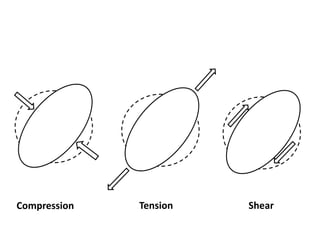Stress and strain ellipsoid
- 1. DOS in Earth Science, University of Mysore Center for Advanced Studies in Precambrian Geology
- 2. Introduction Stress Strain Deformation cept of stress and strain ellipsoids Stress ellipsoid Strain ellipsoid tion between stress and strain ellipsoid Stress and strain ellipsoids
- 3. The aim of structural geologists is to analyse the deformation of rock masses. the deformation of the rock caused by the stress developed in the rocks due to the external force resulted from tectonic plate movements , subduction, and volcanic activity To understand the deformation in rocks we should analyse the stress and strain of that rocks. Stress and strain of the rock geometrically represented by constructing the stress and strain ellipsoids.
- 4. Stress on a rock body is defined as a force applied over an area to cause the deformation. Stress: Tensional compression Shear
- 5. Stress on a rock body is defined as a force applied over an area to cause the deformation. Stress: Tensional compression Shear
- 6. Stress on a rock body is defined as a force applied over an area to cause the deformation. Stress: Tensional compression Shear
- 7. Stress on a rock body is defined as a force applied over an area to cause the deformation. Stress: Tensional compression Shear Stress acting on a plane Normal stress Shear stress Shear stress
- 8. Strain: Strain may be defined as response of rock to the stress, which can be depends on temperature pressure and mineralogical composition of rock.
- 9. Deformation: Changes in the size, shape, position of the body with respect to the original position of the body is known as deformation. DuctileBrittle
- 10. of stress and strain el As the measurement of deformation certain initial body form is required to be known. Geologist deals with the rocks and minerals, so the amount of change in the original shape of the mineral is measure of deformation. But since the minerals are of mixed shape the concept of stress and strain ellipsoids put forth.
- 11. σ1 σ2 tress ellipsoid: Stress ellipsoid or ellipse describes the state of stress at a point in a rock. Greatest stress Minimum stress
- 12. tress ellipsoid: Stress ellipsoid or ellipse describes the state of stress at a point in a rock. Greatest stress(σ1) Minimum stress(σ3) σ1 σ2 σ3
- 13. train ellipsoid: It is the convenient way of visualising deformation is to imagine the change in shape of imaginary sphere or circle. A A' B B'
- 14. train ellipsoid: It is the convenient way of visualising deformation is to imagine the change in shape of imaginary sphere or circle. S1 S2 S3
- 16. n ellipsoid - flinns diag The Flinn diagram is a graphical representation used to plot finite strain ellipsoids. The Flinn diagram describes two main types of strain ellipsoids, cigar and pancake. S1 S2 S3 a = S1/S2 b = S2/S3 K = a-1/b-1
- 18. etween stress and strain The relation is exactly opposite between these ellipsoids in respect to the position of greatest and least principle axis. σ2 σ3 σ1 Stress ellipsoid S2 S3 S1 Strain ellipsoid
- 19. Stress and strain ellipsoids– Rupture The position of the fracture planes and their orientation in field, are very important, because only from such data the direction of actual deformative forces , the orientation of stress and strain ellipsoids can be derived.
- 22. S1 S2 S3 Normal fault Stress and strain ellipsoids -faults
- 23. Thrust fault S2
- 25. Conclusions: Stress and strain ellipsoids can not be constructed in the case of uniform stress conditions Strain ellipsoid represents the effect of deformative forces applied on the body of rock With the help of deformation in rocks we can construct the strain ellipsoid, from strain ellipsoid and with other evidences orientation of stress ellipsoid can be draw.
- 26. References : N.W.Gokhale(1996), theory of structural geology ,1st edition CBS publishers and distributors, PP:136 -146 Marland P. Billings(1984), structural geology, 3rd edition Prentice-hall of india private Ltd, PP:159-167, 231-233. Haaken Fossen(2010), structural geology, 1st edition Published by Cambridge university press, PP:30-32,72,23 Ben A. Van Der Pluijm(2004), Earth structure, 2nd edition Published by W. W. Norton & Company, Inc. PP:65,46
- 27. http://www.geosci.usyd.edu.au/users/prey/Teaching/Geol- 3101/Strain/STRAINe.htm http://homepage.ufp.pt/biblioteca/WebBasPrinTecton ics/BasPrincTectonics/Page2.htm http://www.geosci.usyd.edu.au/users/prey/Teaching/ Geol-3101/Strain02/index.html http://www.geosci.usyd.edu.au/users/prey/Teaching/Geol- 3101/EReport03/GroupA/Report2/Kathy_E_Report.html


























